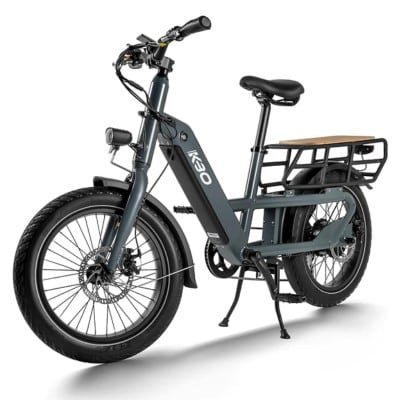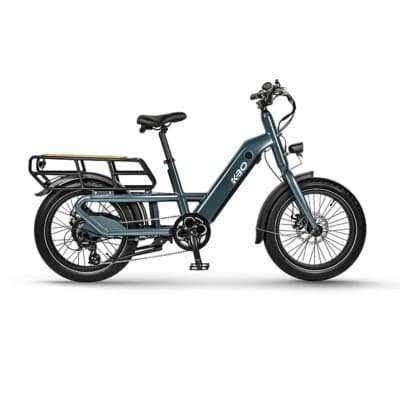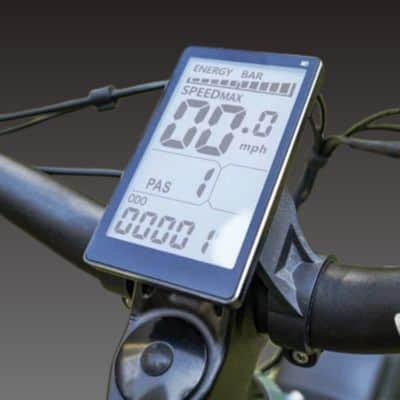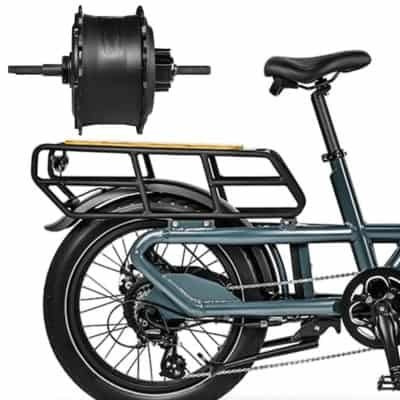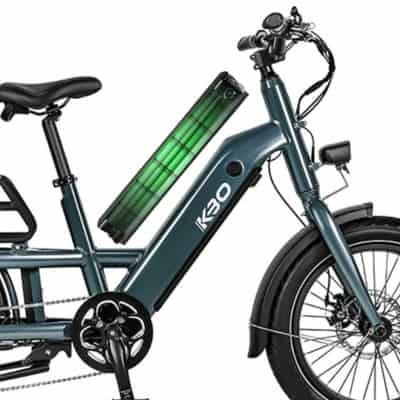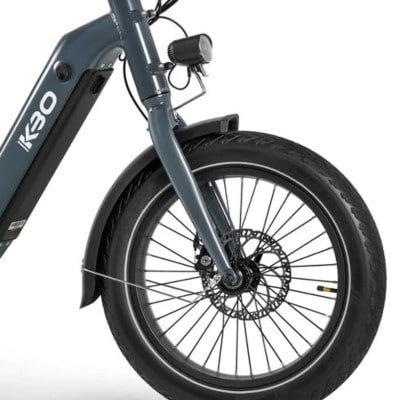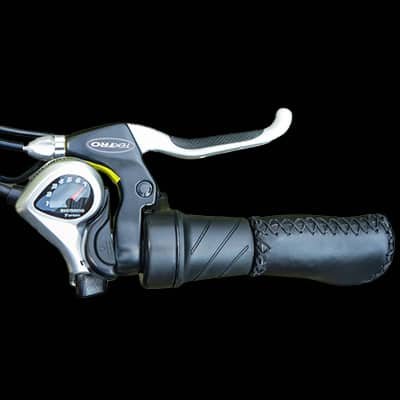Exploring the realm of electric cargo bikes unveils a multitude of choices, each vying for attention. Two of the most popular models are the KBO Ranger and the Trek Fetch+. We've had the chance to test both bikes extensively and are excited to share our thoughts on how they compare.
First, let's talk about the KBO Ranger. This eBike is a budget-friendly option that doesn't skimp on features. It has a powerful motor that can handle hills with ease and a large cargo capacity that can carry up to 400 pounds. We were impressed with how responsive the pedal assist was and how comfortable the bike was to ride. However, there were a few downsides, such as the slightly laggy pedal assist and the fact that it's not as long as some other cargo bikes on the market.
Now, let's turn our attention to the Trek Fetch+ 2. This eBike is a bit more expensive than the KBO Ranger, but it also has some impressive features. The cargo area is customizable and can be configured in a variety of ways to suit your needs. The bike also has a powerful motor and a long battery life, making it a great option for longer rides. However, we did find that the bike was a bit heavy and cumbersome to maneuver, especially when fully loaded.
VS
Appearance & Design
The KBO Ranger eBike and Trek Fetch+ 2 both have unique designs that cater to different types of riders. The KBO Ranger has a sleek, modern design that is perfect for urban commuting and running errands. Its 6061 aluminum frame is lightweight yet sturdy, making it easy to maneuver in tight spaces. The bike frame is also designed to accommodate a variety of cargo, including groceries, luggage, and even pets.
On the other hand, the Trek Fetch+ 2 has a more traditional design that is geared towards families. Its long-tail cargo bike design allows for the transportation of multiple children, cargo, or a combination of both. The extended rear rack provides ample space for carrying everything from backpacks to camping gear. The Fetch+ 2 also comes with a variety of accessories, including a headlight and a rear light.
When it comes to color options, the KBO Ranger is available in cool grey and orange, while the Trek Fetch+ 2 comes in a variety of colors, including galactic grey, lava, and blue sage. Both bikes have a clean, minimalist aesthetic that is sure to turn heads on the road.
Overall, the appearance and design of both the KBO Ranger and Trek Fetch+ 2 are well thought out and cater to specific types of riders. The KBO Ranger is perfect for those who prioritize style and versatility, while the Trek Fetch+ 2 is ideal for families who need a bike that can handle multiple passengers and cargo.
Display and Controls
Display and controls are essential components that can make or break the riding experience. In this section, we will compare the display and controls of the KBO Ranger and the Trek Fetch+ 2.
The KBO Ranger comes equipped with a large and clear LCD display that shows important information such as battery level, speed, pedal assist level, and odometer readings. The display is easy to read, even in bright sunlight, and provides all the necessary information at a glance. The controls are conveniently located on the right side of the handlebars, and the Shimano thumb shifter allows for easy and precise gear changes. The controller on the KBO Ranger is intuitive and responsive, making it easy to adjust the pedal assist level on the fly.
The Trek Fetch+ 2, on the other hand, doesn’t come with a LCD display but it features a LED panel that indicates pedal-assist level and buttons to control the bike’s electrical system. The Trek Fetch +2 also supports smartphone connectivity and even comes with a durable smartphone holder.
Overall, both the KBO Ranger and the Trek Fetch+ have good displays and controls, but the KBO Ranger is slightly better in terms of ease of use and responsiveness. The Shimano thumb shifter on the KBO Ranger is a nice touch, and the intuitive controller makes it easy to adjust the pedal assist level on the fly.
Weight and Weight Limits
When it comes to electric bikes, weight is an important factor to consider. We looked at the weight and weight limits of the KBO Ranger eBike and the Trek Fetch+ 2 to see how they compare.
The KBO Ranger eBike has a total weight capacity of 400 lbs, including the rider. The rear rack can hold up to 120 lbs, which is great for carrying cargo. The bike itself weighs around 77 lbs, which is on the heavier side for an eBike, but it's a tradeoff for the high weight capacity.
On the other hand, the Trek Fetch+ 2 has a weight limit of 440 lbs, including the rider. The bike weighs around 68 lbs, which is lighter than the KBO Ranger eBike.
Overall, the Trek Fetch+ 2 eBike is a better option if you need to carry heavy loads or have a higher weight capacity requirement. Also, if weight is a major concern, the Trek Fetch+ 2 is also a good option since it weighs less than the KBO Ranger.
In summary, the Trek Fetch+ 2 has a higher weight limit and is lighter, while the KBO Ranger eBike has a lower weight limit and is heavier. Which one you choose depends on your specific needs and preferences.
Motor & Power
In this section, we will compare the KBO Ranger and Trek Fetch+ 2 in terms of their motor and power.
The KBO Ranger is equipped with a powerful 750W rear hub motor, which provides ample power for most riding situations. We found the motor to be responsive, and it provided a smooth and comfortable ride. The motor is also relatively quiet, which is a plus if you plan on using the bike for commuting or leisurely rides.
On the other hand, the Trek Fetch+ 2 comes with a mid-drive motor with a lower power rating than the KBO Ranger’s hub motor. The Trek Fetch+ 2 comes with a 250W Bosch smart system Performance Line CX motor that can generate up to 85NM of torque.
While this motor might not have the same power rating as the KBO Ranger’s, it is more efficient and better in some situations. The motor is also responsive and provides a smooth ride. One thing we liked about the Trek Fetch+ 2 motor is that it is very quiet, which is ideal if you plan on using the bike for commuting or leisurely rides.
Both bikes come with a pedal assist system that provides varying levels of assistance depending on the rider's pedaling. The pedal assist system on the KBO Ranger is slightly more responsive than the Trek Fetch+ 2. However, we found that both systems provided adequate assistance and made riding the bikes easier and more enjoyable.
In terms of power, both bikes are capable of reaching speeds of up to 20mph. However, the KBO Ranger has a slightly longer range than the Trek Fetch+ 2, thanks to its larger battery. This is something to consider if you plan on using the bike for longer rides or commutes.
Overall, both bikes have powerful motors and provide ample power for most riding situations. Ultimately, the choice between the two will depend on your specific needs and preferences.
Battery Capacity and Range
The KBO Ranger comes with a 48V 17.5Ah lithium-ion battery that has a capacity of 840 Wh. According to KBO, this battery can provide a maximum range of 60 miles on a single charge. However, in real-world conditions, the range may vary depending on factors such as terrain, rider weight, and riding style. We found that the KBO Ranger's battery can easily provide a range of 40-50 miles on a single charge, which is impressive for an eBike in this price range.
On the other hand, the Trek Fetch+ 2 comes with a 500 Wh Bosch battery that provides a range of up to 50 miles on a single charge. While the range is lower than the KBO Ranger, it's still decent for an eBike in this category. However, if you plan to go on longer rides, you may need to carry an extra battery or a quick charger with you.
In terms of charging time, the KBO Ranger's battery takes around 6-7 hours to fully charge using the included charger. However, if you opt for a quick charger, you can reduce the charging time to around 3-4 hours. On the other hand, the Trek Fetch+ 2 takes around 4-5 hours to fully charge using the included charger.
Overall, the KBO Ranger has a more powerful and longer-lasting battery than the Trek Fetch+ 2. If you're looking for an eBike that can provide a longer range and faster charging times, the KBO Ranger is the way to go.
Ride Quality & Handling
When it comes to ride quality and handling, the KBO Ranger and Trek Fetch+ 2 both have their strengths and weaknesses. Here's what we found during our testing:
Overall, both the KBO Ranger and Trek Fetch+ 2 provide a comfortable and stable ride, but the Trek Fetch+ 2's adjustability and wider handlebars may make it a better option for riders of different sizes and those carrying heavier loads. However, the KBO Ranger's compact size and nimble handling may be a better fit for riders who prioritize maneuverability over adjustability.
VS
Suspension, Brakes, Wheels & Tires
Both the KBO Ranger and the Trek Fetch+ 2 are equipped with rigid forks, which means they lack suspension systems. While this design choice might result in a more direct transfer of power to the ground, it could also lead to a potentially rougher ride on uneven surfaces. Moving on to tire specifications, the Trek Fetch+ 2 features 20” x 2.35” tires, providing a balance between agility and stability. On the other hand, the KBO Ranger boasts wider 20” x 3” tires, offering increased traction and potentially smoother rides over various terrains.
Considering the absence of suspension in both models, riders might experience a bit more impact from bumps and rough patches. The choice between the two tire sizes comes down to the intended riding conditions. The Trek Fetch+ 2's narrower tires could excel in urban environments and moderate trails, offering agility and ease of maneuverability. Meanwhile, the KBO Ranger's wider tires might be better suited for off-road adventures, as they provide enhanced grip and stability on uneven surfaces.
Ultimately, the decision between the two comes down to personal preference and the type of riding experience you prioritize. If you're leaning towards urban commuting and occasional trails, the Trek Fetch+ 2's tire size might be more appealing. On the other hand, if you're seeking off-road capabilities and more traction, the KBO Ranger's wider tires could be the better choice.
Pedal Assist & Throttles
The KBO Ranger eBike offers both pedal assist and throttle while the Trek Fetch+ 2 only comes with pedal assist.
Pedal Assist (PAS)
Pedal assist, also known as PAS, is a system that uses sensors to detect when you are pedaling and provides assistance accordingly. The level of assistance can usually be adjusted, with higher levels providing more power. This means that the harder you pedal, the more assistance you receive.
The KBO Ranger eBike and the Trek Fetch+ 2 both offer multiple levels of pedal assist, allowing you to choose the amount of assistance that best suits your needs. Both eBikes also feature a 5-level pedal assist system.
Throttle
A throttle is a lever or button that allows you to control the motor without pedaling. The KBO Ranger eBike features a twist throttle, which is an ergonomic half twist throttle that is easy to use.
Using the throttle, you can control the speed of the bike without having to pedal. This is useful if you need to take a break from pedaling, or if you need an extra boost of power to get up a hill or accelerate quickly.
Which is Right for You?
The choice between pedal assist and throttle ultimately comes down to personal preference. If you enjoy pedaling and want to get some exercise while you ride, then pedal assist may be the better option for you. On the other hand, if you want the option to take a break from pedaling or need extra power to get up hills, then a throttle may be more suitable.
The KBO Ranger eBike offers both pedal assist and throttle options, giving you the flexibility to choose the mode that works best for you. The Trek Fetch+ 2 on the other hand only supports pedal assist which might make it a little less attractive to people who are not looking to exert much energy while riding their electric bikes.
Portability
The KBO Ranger and the Trek Fetch+ 2 exhibit notable differences in terms of their wheelbases. The KBO Ranger boasts a compact wheelbase of 47 inches, which could contribute to improved agility and maneuverability. This characteristic makes it well-suited for navigating through tight spaces and urban environments. On the other hand, the Trek Fetch+ 2 boasts a longer wheelbase of 53.74 inches. A longer wheelbase often translates to enhanced stability at higher speeds and better handling over uneven terrains. This could make the Trek Fetch+ 2 a solid choice for riders seeking more stability during rides, particularly on trails and varied surfaces.
It's important to consider how you intend to use the ebike. If you're primarily riding in urban settings where agility is crucial, the KBO Ranger's shorter wheelbase could be advantageous. Its ability to navigate through traffic and tight corners might make it a preferred option for city commuters. Conversely, if you're planning on covering longer distances or tackling more challenging terrains, the Trek Fetch+ 2's longer wheelbase might provide a smoother and more stable riding experience.
Both bikes' non-foldable design is worth noting. While foldable bikes offer convenience for storage and transportation, the sturdier frame of non-foldable bikes often contributes to better overall performance and durability. If you prioritize ride quality and stability over compact storage, the non-foldable design of both the KBO Ranger and the Trek Fetch+ 2 might align well with your preferences.
Ultimately, your choice should be guided by your intended usage and priorities. If agility and urban maneuverability are paramount, the KBO Ranger's shorter wheelbase might be more appealing. However, if you're looking for stability on diverse terrains, the Trek Fetch+ 2's longer wheelbase could be the better fit.
Pros & Cons KBO Ranger vs Trek Fetch+ 2
Pros of KBO Ranger
Cons of KBO Ranger
Pros of Trek Fetch+ 2
Cons of Trek Fetch+ 2
Overall, both the KBO Ranger and the Trek Fetch+ have their pros and cons, and the best option for you will depend on your specific needs and preferences.
Specifications and Features Table
Let's take a closer look at the specifications and features of the KBO Ranger eBike and the Trek Fetch+ 2.
Specification/Feature | KBO Ranger | Trek Fetch+ 2 |
|---|---|---|
Frame Material | Aluminum | High-performance hydroformed alloy |
Motor | 750W Rear Hub | Bosch Performance Line CX 250W |
Battery | 48V 17.5Ah | Bosch PowerTube 500Wh |
Range | Up to 60 miles | Up to 65 miles |
Wheel Size | 20 inches | 20 inches |
Weight | 77 pounds | 68 pounds |
Load Capacity | 400 pounds | 440 pounds |
The KBO Ranger comes with a 750W rear hub motor, while the Trek Fetch+ 2 has a Bosch Performance Line CX 250W motor. The KBO Ranger has a 48V 17.5Ah battery, while the Trek Fetch+ 2 has a Bosch PowerTube 500Wh battery. The Trek Fetch+ 2 has a longer range of up to 65 miles compared to the KBO Ranger's 60-mile range. The KBO Ranger has 20-inch wheels, while the Trek Fetch+ 2 also has 20-inch wheels. The KBO Ranger is heavier at 77 pounds, while the Trek Fetch+ 2 weighs 68 pounds. The Trek Fetch+ 2 has a higher load capacity of 440 pounds compared to the KBO Ranger's 400-pound capacity.
In terms of features, both bikes have some similar accessories such as a kickstand, rear rack, and center stand. The KBO Ranger has running boards, while the Trek Fetch+ 2 has a kickstand and ergonomic grips. The Trek Fetch+ 2 also has a taillight, a smartphone grip display, and spokes.
Overall, both bikes have impressive specifications and features that make them great options for those in need of a reliable and sturdy electric cargo bike.
Overall Recommendation Based on Intended Use
Both bikes have their strengths and weaknesses, so it's important to consider your specific needs before making a decision.
If you're looking for a reliable electric cargo bike for running errands or making deliveries, the KBO Ranger may be the better choice. It has a range of up to 60 miles on a single charge, making it perfect for longer trips. The cargo carrying capacity is also impressive, with a weight limit of up to 400 pounds. The KBO Ranger is also more affordable compared to other electric cargo bikes on the market.
On the other hand, if you're looking for a more versatile bike that can handle a variety of terrains, the Trek Fetch+ 2 may be a better fit. It has a powerful motor that can assist you up hills and over rough terrain.
Both bikes have their own unique features and benefits, so it's important to consider your specific needs before making a decision. If you plan to use the bike primarily for running errands or making deliveries, the KBO Ranger is a solid choice. However, if you want a bike that can handle a wider variety of terrains and conditions, the Trek Fetch+ 2 may be the better option.
Ultimately, the choice between the KBO Ranger and the Trek Fetch+ 2 comes down to personal preference and intended use. We recommend taking both bikes for a test ride to see which one feels more comfortable and suits your needs best.
VS

